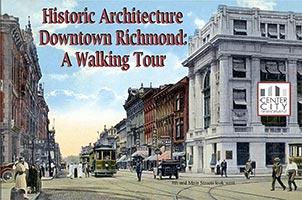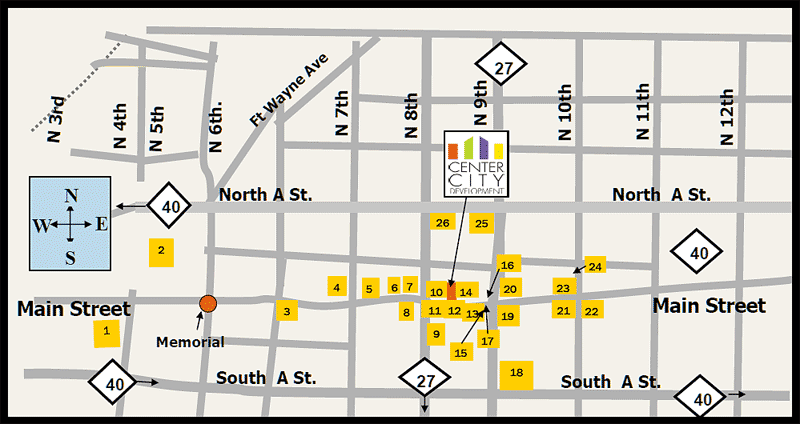 One Click...
One Click...
to all things local!
Historic Architecture Downtown Richmond:
A Walking Tour
Richmond's Downtown District
 In 1806, President Thomas Jefferson signed the bill that established the National Road (America's Main Street). It would cross seven states and create a corridor for settlers moving west. By 1827, the National Road had reached Richmond, Indiana. When Richmond was settled in 1805 by Quakers from North Carolina, the commercial trade was largely concentrated on Front Street (now South 4th St.), facing the Whitewater River. The National Road quickly became Richmond's new Main Street. Retailers relocated their businesses to greet settlers moving west.
In 1806, President Thomas Jefferson signed the bill that established the National Road (America's Main Street). It would cross seven states and create a corridor for settlers moving west. By 1827, the National Road had reached Richmond, Indiana. When Richmond was settled in 1805 by Quakers from North Carolina, the commercial trade was largely concentrated on Front Street (now South 4th St.), facing the Whitewater River. The National Road quickly became Richmond's new Main Street. Retailers relocated their businesses to greet settlers moving west.
Early buildings on Main Street were largely simple, two-story structures of Federal or Greek Revival styles, similar to those that can be seen today in nearby Centerville, Indiana. These soon gave way to a more popular style of the taller Italianate architecture, in vogue during the 1850s to 1890s, such as the first Knollenberg's building built in 1877. The influence of the Queen Anne style, more common in residential architecture, can be seen in the eastern half of Knollenberg's built ten years later in 1888. Both buildings were designed by the Richmond Architect, John A. Hasecoster.
Memorial to victims of the April 6, 1968 explosion. As Richmond grew, having become a railroad center and the county seat of Wayne County, new commercial and public buildings such as the Courthouse were built in the Richardsonian Romanesque style. After the turn-of-the-century, new architectural styles prevailed, and buildings such as Star Bank (then Dickinson Trust Co.) and Hoppe Jewelers (Tivoli Theater) exhibited a Neo-Classical or Beaux Arts influence. Later architectural trends can be seen in the Art Deco building that S.S. Kresge Co. built at 801 East Main Street.
April 6, 1968 was a tragic day for Richmond, Indiana. A double explosion occurred at 1:47 P.M. EST in downtown Richmond, killing 41 people and injuring more than 150. The first explosion was due to a natural Gas leak from faulty transmission lines under the Marting Arms sporting goods store, located at 6th and Main Streets. A secondary explosion was caused by barrels of gunpowder stored in the basement of the building. Twenty buildings in and around the site were condemned as a direct result of the explosions.
The award-winning design for rebuilding the downtown closed off five blocks of Main Street and became the Promenade. This was a popular trend of modernizing that was influenced by the walking mall and shopping center designs. Another part of competing with emerging shopping centers had merchants ―updating their storefronts with metal or glass panels over the front of the buildings that masked the historic architecture.
Today, this trend has largely been reversed. The Promenade was removed in the mid—1990s and Main Street was returned to through traffic. People look at the outstanding collection of historic architecture in Richmond as a resource.
As you walk down Richmond's Main Street, look up and see the evidence of this community's rich history as it is displayed in the architecture of its Main Street. Now nominated (listed in 2011, #11000918) for the National Register of Historic Places, the architectural richness has been nationally recognized.
| Quick Navigation | ||
| Next ⇒ | ||
Locate on a Map
|
|
Acknowledgments & Notices
Note: This is the web-based incarnation of a brochure originally published in 2010. While the history is still very valuable, other information may no longer be accurate. Information updated by WayNet will be listed in this orange color.
Original brochure produced by Center City Development Corporation.
Brochure Committee:
- Lynn L. Johnstone
- Greg Bottorff
- Julie Dishman
- Morrisson-Reeves Library Staff:
- Sue King, Archivist
- Doris Ashbrook, Reference Services
- Wayne County Historical Museum:
- Jim Harlan Director
This project was made possible by a grant from the Richmond Urban Enterprise Association.
**COPYRIGHT NOTICE** for Walking Tour Information: Published in March 2010 In accordance with Title 17 U.S.C. Section 107, any copyrighted work in this article is distributed under fair use without profit or payment to those who have expressed a prior interest in receiving the included information for non-profit research and educational or criticism purposes only.
![]()
![]()
![]()
![]()
Location
Downtown Richmond, Indiana, between North and South A, and 3rd to 10th Streets.
Map
Admission
Free
Hours
Public Access
Printed Brochure
For a printed copy of this brochure, please contact: VisitRichmond.org
|
This jQuery slider was created with the free EasyRotator software from DWUser.com.
Need a powerful Flash slideshow creator with built-in iPhone/iPad/Android support? EasyRotator is supported by the XML Flash Slideshow v4 Software. OK |
This jQuery slider was created with the free EasyRotator software from DWUser.com.
Need a powerful Flash slideshow creator with built-in iPhone/iPad/Android support? EasyRotator is supported by the XML Flash Slideshow v4 Software. OK |
|
This jQuery slider was created with the free EasyRotator software from DWUser.com.
Use WordPress? The free EasyRotator for WordPress plugin lets you create beautiful WordPress sliders in seconds. OK |
This jQuery slider was created with the free EasyRotator software from DWUser.com.
Use WordPress? The free EasyRotator for WordPress plugin lets you create beautiful WordPress sliders in seconds. OK |
Featured Member
Did You Know?
Wayne County Fast Facts
| Location: | East Central Indiana, USA |
| Founded: | 1810 |
| Population: | 66,456 |
| Elevation: | 1,257 feet Highest Point in Indiana |
| County Seat: | Richmond |
| Local Time: | |
| Date: | |
| About Indiana: | IN.gov |
| Current Weather: |
Follow Us
Contact Us
| Email: | info@waynet.org |
| Phone: | 765.939.0857 |
| Mail: | 50 North 5th St. Richmond, IN 47374 |
| Director: | Board of Directors |
Stay in Touch
Sign up for WayNet News
- our e-newsletter.
Translate This Page
Join WayNet
About WayNet
Waynet, Inc. is a non-profit, 501(c)4 corporation that is fully-funded through memberships. Please support our members and let them know you located them via WayNet.org.
Top 25: popular pages & circulation information.
Our Recent Tweets
Copyright © Waynet, Inc. 2022, All Rights Reserved.| Policies
Directory | News | Discover | Find It Fast | Knowledge | To Do | Members


























